The 2019 Emerging Leader in Atomic Spectroscopy Award
Spectroscopy
This year’s Emerging Leader in Atomic Spectroscopy, Dominic Hare, is a forerunner in developing laser ablation–inductively coupled plasma–mass spectrometry methods for in situ analysis of trace elements in tissue to investigate the presence of biometals related to neurodegenerative diseases.
This year's award recipient, Dominic James Hare, is a forerunner in the use of laser ablation–inductively coupled plasma–mass spectrometry for in situ analysis of trace elements in tissue. His work has led to improved understanding of the mechanisms and therapeutics of biometals related to neurodegenerative diseases.
Dominic J. Hare
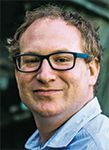
Dominic J. Hare Dominic J. Hare is a Principal Research Fellow and Head of Atomic Pathology Laboratory in the Melbourne Dementia Research Centre at The Florey Institute of Neuroscience and Mental Health in Melbourne, Australia, and holds adjunct appointments at the University of Melbourne's School of Medicine, the Brain and Mind Brain Centre at the University of Sydney, and the Elemental Bioimaging Facility at his alma mater, the University of Technology, Sydney. He is the winner of the 2019 Emerging Leader in Atomic Spectroscopy Award, which is presented by Spectroscopy magazine. This annual award recognizes the achievements and aspirations of a talented young atomic spectroscopist who has made strides early in their career toward the advancement of atomic spectroscopy techniques and applications. The award will be presented to Hare at The European Winter Conference on Plasma Spectrochemistry (EWCPS), in Pau, France, February 3-8, 2019, where he will give a lecture and be honored in an award symposium.
Hare earned his B.S. in applied chemistry at the University of Technology, Sydney, Australia in 2005. He continued with his studies to earn a PhD in science from the University of Technology in Sydney in 2009, and has continued to work toward an MPhil in medicine from the University of Melbourne. He has published nearly 90 peer-reviewed papers, four book chapters, and has presented 20 papers at scientific conferences. He has received several awards and scholarships, including the Robert K Murphy Research Prize, the France-Australia Science Innovation Collaboration Fellowship, the University of Technology Sydney Vice Chancellor's Award, and the Australian Institute of Policy and Science
Imaging Metals in Biological Tissue
Hare's work in atomic spectroscopy focuses on the use of laser ablation–inductively coupled plasma–mass spectrometry (LA-ICP-MS) for imaging metals in biological tissue. His work can be divided into two major research themes: method development, and the study of metals in neurodegenerative diseases for infants, children, and adults.
Atomic spectroscopy is being applied to neuroscience research to understand how redox-active metals, particularly iron, are involved in the pathology of Alzheimer's and Parkinson's disease. The application of atomic spectroscopy has extended beyond LA-ICP-MS to include other techniques, such as immunohistochemistry for simultaneous imaging of metal-tagged biomolecules, combined with tissue elemental composition mapping. Hare has been directly involved in establishing a dedicated Atomic Pathology laboratory at the Florey Institute to study the complex interactions between metal ions and the many proteins that rely on metals for normal physiology and morphology. Hare and his research team have used these skills to examine how metals such as iron, zinc, manganese, and lead may (or may not) have future use as biomarkers of Alzheimer's and Parkinson's disease. He and his co-workers are exploring the direct application and understanding of metals content to neurodegenerative disease research. Their goal is to develop chemical images relating to the atomic, functional protein, and other biomolecule markers in tissue that can be used to measure subtle chemical changes before, during, and after the appearance of classic structural changes typical of disease. This research may provide information on the inner workings of the cell and the fundamental basis of disease onset, leading to new therapies and earlier detection.
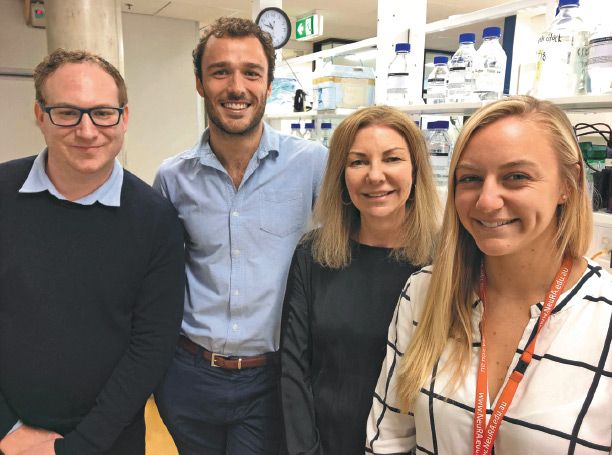
Figure 1: Dominic Hare's current research team. Left to right: Hare, Benjamin Trist, a post-graduate researcher; Associate Professor Kay Double, and researcher Sian Genoud. (Photo courtesy of Benjamin Trist.)
Since completing his doctorate in 2009, Hare has achieved several major milestones in the field of LA-ICP-MS imaging method development. These include the advancement and validation of a fully quantitative method for imaging metals in neurological tissue sections (1,2); the reconstruction of three-dimensional imaging atlases of metals in the mouse brain (3,4); the development of new imaging and data analysis software (5); and the development of a single-cell imaging technique using LA-ICP-MS (6).
Understanding Redox-Reactive Metals and Their Relationship to Alzheimer's and Parkinson's Disease
Hare has translated his skills in atomic spectroscopy to applied neuroscience research, primarily focusing on understanding how redox-active metals, particularly iron, are involved in Alzheimer's and Parkinson's disease pathology. This work has extended beyond the exclusive use of LA-ICP-MS to include other techniques and a dedicated, well-equipped metalloproteomics research laboratory, which is used for exploration and the study of the complex interactions between metal ions and numerous proteins that rely on metals for healthy function. Hare has published seminal papers on the presence of iron, manganese, and lead related to their concentration in tissue structures, and in the identification of metal biomarkers in Alzheimer's disease (7–9). The Florey metalloproteomics laboratory has become focused on the development of new atomic spectroscopy methods and their direct application to neurodegenerative disease research.

Figure 2: Hare in his laboratory. (Photo courtesy of Prof. Elizabeth New.)
Hare has also diversified his analytical skills to encompass synchrotron-based techniques for atomic spectroscopy, and has published this research. He is a regular user of the Australian Synchrotron's X-ray fluorescence microscopy beamline (10-12); and a frequent collaborator with the European Synchrotron Radiation Facility (13).
Iron in Child and Adolescent Health
Hare's commitment to translating analytical methods to public health culminated in 2017 in the publication of an important article in Lancet Child and Adolescent Health (14), discussing the need for empirical data using cutting-edge technology to set guidelines for iron supplementation to healthy infants. His work has appeared in a wide range of scientific journals, including Trends in Neurosciences and Chemical Communications, in which he was named an Emerging Investigator.
The Latest Research
Some of Hare's latest research involves collaborative work with a multidisciplinary team to create image maps of the atomic, molecular, and biochemical composition of tissue (15). The tools for this work include atomic and molecular spectroscopy, as well as immunohistochemistry. These tools, when combined with sophisticated data analysis and imaging software, allow integrated and specific image mapping of biomolecules and tissue composition. These spatial maps, showing the presence and location of various atomic and molecular cell components, provide detailed and invaluable information on cell physiology and structure allowing comparison of healthy and diseased tissues. Minimal disruption of tissues during analysis is key to understanding the fundamental nature of cell metabolic and structural changes related to disease apart from those that may be the result of the analysis process itself. Such new tools for imaging tissue composition will provide new insights into primary questions related to cell function and structure.
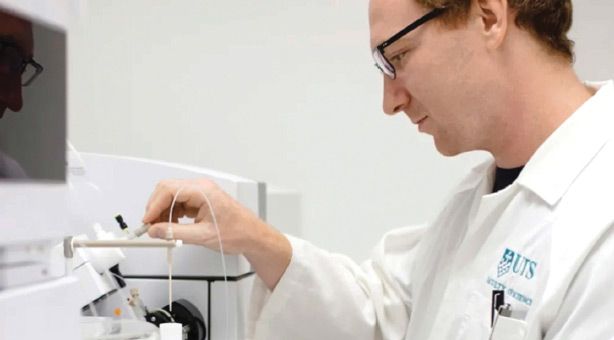
Figure 3: Hare preparing instrumentation for analysis. (Photo courtesy of Prof. Philip Doble.)
Bringing New Analytical Technology to Medical Researchers
When we asked others about the importance of Hare's work, they cited not only the specifics of his research, but the fact that he has introduced new analytical technology to biology and medical researchers, enabling them to advance their work.
Professor Ashley I. Bush, the Director of the Oxidation Biology Unit at the Florey Institute and a mentor to Hare, is one of those who has benefited in this way. "I first began collaborating with Dr. Hare in 2007, at a time when the concept of laser ablation-inductively coupled plasma-mass spectrometry was foreign to me," Bush said in a letter supporting Hare's nomination for the award. "When Dr. Hare obtained the funding to install such a system within our laboratory, I was particularly enthused, as it provides a direct pipeline from a functional neuroscience research laboratory to an analytical technique not normally accessible to us." Since then, Bush said, this technology has been a key component of a number of major publications and grant applications, and Hare's collaborative work, using LA-ICP-MS in neuroscience research, has been published in leading journals across multiple disciples-in general science (Nature, Scientific Reports), chemistry (Chemical Science, Analytical Chemistry), neuroscience journals (Journal of Neuroscience, ACS Chemical Neuroscience), as well as appearing many times in Metallomics.
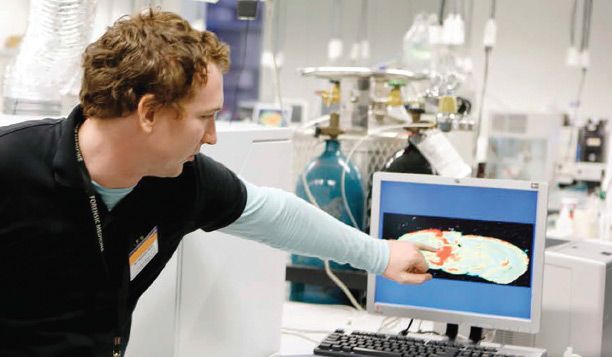
Figure 4: Hare in the laboratory, demonstrating metallomic imaging technology of metals in mouse brain tissue. (Photo courtesy of Prof. Kay Double.)
"Dominic was one of the early pioneers of elemental bio-imaging and was a key player in bringing the technology to the attention of biologists and neuroscientists," said Prof. Philip Doble of the University of Technology Sydney, who was Hare's PhD supervisor. "He developed the methods for accurate and precise quantification during his PhD and post-doctoral fellowship, and was the first person to apply elemental bio-imaging to neurogenerative disorders such as Parkinson's disease." Hare's founding of the Atomic Pathology Laboratory at the Florey Institute was significant for the continuation of this work, Doble believes. "This laboratory continues to push the boundaries of the application of spectroscopy in neuroscience, and more recently elemental profiles of various cancers, which may have implications for novel treatments and diagnostics," he said.
Professor Peter Crouch of the University of Melbourne is another researcher who learned LA-ICP-MS from Hare-who, as Crouch notes, learned it from Doble at the University of Technology Sydney. Initially, Hare took samples from Crouch's laboratory in Melbourne and ran them in Sydney, until eventually Crouch had the funding to set up his own LA-ICP-MS system. "I'm now a full convert to the virtues of LA-ICP-MS in biomedical research and every new project has LA-ICP-MS in there somewhere," Crouch said. "I'm very excited about the projects that we're currently working on and even more excited about what's coming next."
Professor Kay Double, a member of the Brain and Mind Centre at the University of Sydney, also values the tools Hare has shared and developed. "Dominic has made significant contributions to the development of new technologies in spectroscopy, particularly to tools which have improved quantitative studies of central nervous system tissues," she said.
"One of Dominic's greatest contributions to date has been his work in pioneering the translation of LA-ICP-MS imaging to applied medical research," echoed Professor Elizabeth New, of the School of Chemistry at the University of Sydney. "To achieve this, he needed to develop the best standards, and to identify the best methods of sample preparation. He has also established the first LA-ICP-MS imaging laboratory within a neuroscience research institute, allowing him to achieve milestones like the first atlas of metals in the mouse brain."
Dr. David Bradley, the Academia and Collaborations Manager at Agilent Technologies, also emphasized the importance of the atomic pathology laboratory that Hare established. "[It brings] elemental imaging, chemical analysis, and biological approaches to change the paradigm of medical research and translation of that into real world biological questions and systems," he said.
Rooted in Good Science, and Working Across Disciplines
Benjamin Trist, a mentee of Hare's and a postgraduate researcher at the University of Sydney, noted that what makes Hare successful is not just that he brings new analytical techniques to medicine, but that he believes strongly in a rigorous approach to his work. "Dominic's brilliance comes not only from his own intellectual rigor, but his passion for science and the advancement of knowledge," Trist said. "His scientific approach is one that epitomizes the ideologies of open science, with the belief that transparency and collaboration arm us with a greater capacity to solve the most complex of problems."
It is this principle, Trist said, that has led Hare to develop an expansive, international, and multidisciplinary research network to enable some of his most significant career achievements. "Dominic will continue to bridge international experts across multiple fields, facilitating cross-disciplinary collaborations that employ cutting-edge analytical technologies to address increasingly novel and exciting ideas," Trist said.

Figure 5: The Research Group at Florey Institute of Neuroscience and Mental Health and The University of Melbourne. Back row: L-R Dr. Kai Kysenius, Dr. Bence Paul, Dr. Stuart Portbury (honorary member); Middle row: Jessica Billings, Associate Prof. Dominic Hare, Dr. Amy Heffernan (former and honorary member); Dr. Erin McAllum. Front: Tracy Zhang. (Photo courtesy of Prof. Ashley Bush.)
David Bradley agrees. "Dominic brings a novel and wonderful approach to collaboration through being very inclusive, open, and considerate of others, particularly young scientists," he said. "His approach to complex biological questions through the inclusion of disciplines that are complementary and orthogonal is a model for the new world of collaboration."
Bush echoed this point. "[Hare's] considerable skill in collaborating has also brought in new researchers and industry partnerships, as evidenced by the strong presence of atomic spectroscopy technology within my laboratory," Bush said. "He is a shining example of applied spectroscopy research."
Elizabeth New supports this contention. "Dominic is one of the leading researchers in the thriving neuroscience institute in which he works," she said. "He is starting to collaborate widely to use a broad range of techniques to uncover the causes of neurodegenerative disease."
"Dominic is a world class scientist that has united the fields of Analytical Chemistry and Neuroscience," said Philip Doble.
But although Hare is an excellent collaborator, he also works well alone, says Bush. Hare spent four years in Bush's group at the Florey Institute as a visiting researcher, before growing to become a senior member of the Melbourne Dementia Research Centre, a laboratory head, and a key part of the transdisciplinary program that the research center is spearheading. "I'm technically Dominic's boss now since he joined the Florey Institute officially in 2017, though I find he's often best left to his own devices," Bush said. "It's more exciting when he drops by and starts a sentence with 'Ashley, I think I might have found something...' or 'I have an idea . . .'".
Those ideas have led to significant results. "The contributions he has made to understanding the role of metals in neurodegenerative diseases are substantial and diverse," continued Bush. "His main focus on iron and Parkinson's disease, which after ten years of work has yielded many new discoveries, all while he's continued to develop the unique imaging technology."
Advice to a Young Scientist: Hard Work and Persistence Matters
Although Hare has had so much success, like many others he had to learn the value of persistence. Hare's research advisor, Philip Doble, remembered a time, from early in Hare's PhD studies, when Hare presented the failed results of a fourth attempt to master microwave digestion, and was getting frustrated. "I remember my response was blunt," said Doble. "'Do it again. You're an analytical chemist, so you need to be able to do this.'" Off Hare went, tried it again, and all went smoothly. Years later Dominic revealed to Doble that the response annoyed him, because it was quite a lot of work using a fairly old, slow, temperamental, and not-so-user friendly microwave. But he acknowledged it was perhaps the best advice Doble had given him during his PhD studies-that persistence is the key to success. "He told me recently that he relayed this anecdote to a new student in his lab and had the same results, with the experiment working out perfectly for her at the next attempt," said Doble.
Hare didn't just pass this lesson on to his students; he puts it into practice on a daily basis. Benjamin Trist remembered a time when he was working with Hare at the Florey Institute and a technical problem arose with the ICP-MS instrument, delaying a very important experiment. When the time came for Trist to fly back to Sydney at the end of the week, barely half of the planned work had been completed. "Dominic worked tirelessly throughout the entire Friday night and early Saturday morning, and managed to complete the experiment to keep the project on track," said Trist. "He will not hesitate to work tirelessly in aid of another's aspirations."
A Bright Future
The researchers surrounding Hare all agree that his future is bright, and that his work holds exciting promise for future discoveries in medicine.
"Dominic will no doubt continue to be a world leader in the application of spectroscopy in the biological sciences," said Doble. "I cannot predict where his research will lead, but I am certain it will be ground breaking."
"I have no doubt Dominic will soon be considered a world-leader in the metallomics of neurodegenerative diseases," added Kay Double.
"Dominic has excellent skills in the lab; he is able to put new scientific discoveries into the context of fundamental biomedical problems," said senior colleague Peter Crouch. "He is a natural mentor and leader, and he is also a big picture thinker, both in the research sense and the operational sense. Science needs people like this."
"I have a bet going with others at work that one day we may hear the news of a Nobel Prize!" said David Bradley.
"The growth of Dominic's atomic pathology laboratory group will see Dominic propelled farther yet into the international research spotlight, where he will continue to make meaningful advances towards the search for treatments for human diseases such as Parkinson's disease, Alzheimer's disease and motor neuron disease," Trist asserted.
"Dominic is a wonderful connector of researchers, and this will ensure that his research impact only continues to increase in the future," concluded New.
The future only knows what will come of this work, but one thing seems certain-that persistence and integrity as demonstrated to date by Dominic Hare are key to successful scientific endeavor.
References
(1) D. Hare, B. Reedy, R. Grimm, S. Wilkins, I. Volitakis, J. George, R. Cherny, A. Bush, D. Finkelstein, and P. Doble, Metallomics 1, 53–58 (2009).
(2) D. Hare, J. Lear, D. Bishop, A. Beavis, and P. Doble, Analytical Methods 5, 1915–1921 (2013).
(3) D. Hare, R. Grimm, S. Wilkins, J. George, R. Cherny, A. Bush, D. Finkelstein, and P. Doble, Metallomics 2, 745–753 (2010).
(4) D. Hare, J. Lee, A. Beavis, A. van Gramberg, J. George, P. Adlard, D. Finkelstein, and P. Doble, Analytical Chemistry 84, 3990–3997 (2012).
(5) B. Paul, D. Hare, D. Bishop, C. Paton, V. Nguyen, N. Cole, M. Niedzwiecki, E. Andreozzi, A. Vais, J. Billings, L. Bray, A. Bush, G. McColl, B. Roberts, P. Adlard, D. Finkelstein, J. Hellstrom, J. Hergt, J. Woodhead, and P. Doble, Chemical Science 6, 5383–5393 (2015).
(6) D. Hare, P. Lei, S. Ayton, B. Roberts, R. Grimm, J. George, D. Bishop, A. Beavis, S. Donovan, G. McColl, I. Volitakis, C. Masters, P. Adlard, R. Cherny, A. Bush, D. Finkelstein, and P. Doble, Chemical Science 5, 2160–2169 (2014).
(7) D. Hare, E. Raven, B. Roberts, M. Bogeski, S. Portbury, C. McLean, C. Masters, J. Connor, A. Bush, P. Crouch, and P. Doble, NeuroImage 137, 124–134 (2016).
(8) D. Hare, J. Doecke, N. Faux, A. Rembach, I. Volitakis, C. Fowler, R. Grimm, P. Doble, R. Cherny, C. Masters, A. Bush, and B. Roberts, Chemical Neuroscience 6, 398–402 (2015).
(9) D. Hare, M. Jones, V. Wimmer, N. Jenkins, M. de Jonge, A. Bush, and G. McColl, Metallomics 8, 156–160 (2016).
(10) S. James, B. Roberts, D. Hare, M. de Jonge, I. Birchall, N. Jenkins, R. Cherny, A. Bush, and G. McColl, Chemical Science 6, 2952–2962 (2015).
(11) S. James, D. Hare, N. Jenkins, M. de Jonge, A. Bush, and G. McColl, Scientific Reports 6, e20350 (2016).
(12) D. Hare, N. Faux, B. Roberts, I. Volitakis, R. Martins, and A. Bush, Metallomics 8, 628–623 (2016).
(13) K. Davies, D. Hare, S. Bohic, S. James, J. Billings, D. Finkelstein, P. Doble, and K. Double, Analytical Chemistry 87, 6639–6645 (2015).
(14) D. Hare, B. Cardoso, E. Szymlek-Gay, and B. Biggs, The Lancet Child & Adolescent Health 2(2), 144–156 (2018).
(15) D.P. Bishop, N. Cole, T. Zhang, P.A. Doble, and D.J. Hare, Chemical Society Reviews 47(11), 3770–3787 (2018).
Jerome Workman, Jr. is the Senior Technical Editor for Spectroscopy and LCGC North America . Direct correspondence to jerome.workman@ubm.com
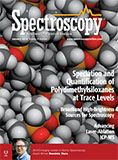
Best of the Week: What You Missed from Pittcon and AAFS
March 14th 2025Top articles published this week include a video interview on the role of near-infrared (NIR) spectroscopy in food and bioanalysis, a recap of an important session at Pittcon, and a dynamic video that summarizes the highlights of the American Academy of Forensic Sciences (AAFS) Conference.
Raman Spectroscopy Aflatoxin Detection Enhances Peanut Safety
March 11th 2025A research team from Jiangsu University has developed a Raman spectroscopy-based method to detect aflatoxin B1 (AFB1) in peanuts with improved accuracy and efficiency. By employing a two-step hybrid strategy integrating backward interval partial least squares (BiPLS) and variable combination population analysis (VCPA), the new model significantly enhances the precision of AFB1 detection, providing a more reliable approach for food safety monitoring.
Advancing NIR and Imaging Spectroscopy in Food and Bioanalysis
March 11th 2025Our full-length interview with Huck covers more than just NIR spectroscopy in food and bio analysis. Spectroscopy sat down with Huck to also discuss current trends going on in spectroscopy, delving into what challenges spectroscopists face today and how they can solve these concerns.